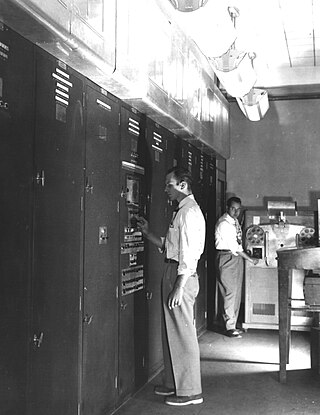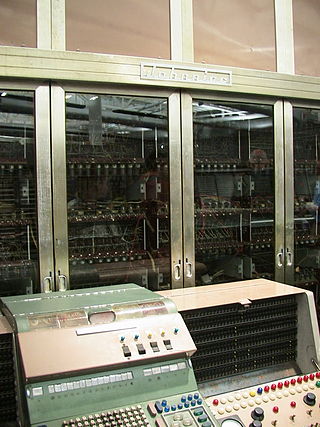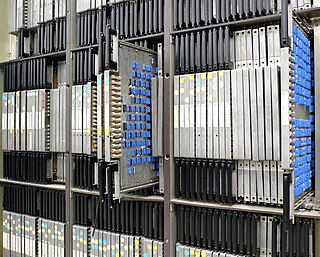Related Research Articles

EDVAC was one of the earliest electronic computers. It was built by Moore School of Electrical Engineering, Pennsylvania. Along with ORDVAC, it was a successor to the ENIAC. Unlike ENIAC, it was binary rather than decimal, and was designed to be a stored-program computer.
BINAC was an early electronic computer designed for Northrop Aircraft Company by the Eckert–Mauchly Computer Corporation (EMCC) in 1949. Eckert and Mauchly, though they had started the design of EDVAC at the University of Pennsylvania, chose to leave and start EMCC, the first computer company. BINAC was their first product, the first stored-program computer in the United States; BINAC is also sometimes claimed to be the world's first commercial digital computer even though it was limited in scope and never fully functional after delivery.

Whirlwind I was a Cold War-era vacuum tube computer developed by the MIT Servomechanisms Laboratory for the U.S. Navy. Operational in 1951, it was among the first digital electronic computers that operated in real-time for output, and the first that was not simply an electronic replacement of older mechanical systems.

The JOHNNIAC was an early computer built by the RAND Corporation and based on the von Neumann architecture that had been pioneered on the IAS machine. It was named in honor of von Neumann, short for John von NeumannNumerical Integrator and Automatic Computer. JOHNNIAC is arguably the longest operational early computer, being used almost continuously from 1953 for over 13 years before finally being shut down on February 11, 1966, logging over 50,000 operating hours.

The IAS machine was the first electronic computer built at the Institute for Advanced Study (IAS) in Princeton, New Jersey. It is sometimes called the von Neumann machine, since the paper describing its design was edited by John von Neumann, a mathematics professor at both Princeton University and IAS. The computer was built from late 1945 until 1951 under his direction. The general organization is called von Neumann architecture, even though it was both conceived and implemented by others. The computer is in the collection of the Smithsonian National Museum of American History but is not currently on display.

The ORDVAC, is an early computer built by the University of Illinois for the Ballistic Research Laboratory at Aberdeen Proving Ground. A successor to the ENIAC. It was based on the IAS architecture developed by John von Neumann, which came to be known as the von Neumann architecture. The ORDVAC was the first computer to have a compiler. ORDVAC passed its acceptance tests on March 6, 1952, at Aberdeen Proving Ground in Maryland. Its purpose was to perform ballistic trajectory calculations for the US Military. In 1992, the Ballistic Research Laboratory became a part of the U.S. Army Research Laboratory.

The ILLIAC I, a pioneering computer in the ILLIAC series of computers built in 1952 by the University of Illinois, was the first computer built and owned entirely by a United States educational institution.
The Cyclone, was a vacuum tube computer, built by Iowa State College at Ames, Iowa. The computer was commissioned in July 1959. It was based on the IAS architecture developed by John von Neumann. The prototype was ILLIAC, the University of Illinois Automatic Computer. The Cyclone used 40-bit words, used two 20-bit instructions per word, and each instruction had an eight-bit op-code and a 12-bit operand or address field. In general IAS-based computers were not code compatible with each other, although originally math routines which ran on the ILLIAC would also run on the Cyclone.

The ILLIAC IV was the first massively parallel computer. The system was originally designed to have 256 64-bit floating point units (FPUs) and four central processing units (CPUs) able to process 1 billion operations per second. Due to budget constraints, only a single "quadrant" with 64 FPUs and a single CPU was built. Since the FPUs all had to process the same instruction – ADD, SUB etc. – in modern terminology the design would be considered to be single instruction, multiple data, or SIMD.

The ILLIAC II was a revolutionary super-computer built by the University of Illinois that became operational in 1962.

The IBM 700/7000 series is a series of large-scale (mainframe) computer systems that were made by IBM through the 1950s and early 1960s. The series includes several different, incompatible processor architectures. The 700s use vacuum-tube logic and were made obsolete by the introduction of the transistorized 7000s. The 7000s, in turn, were eventually replaced with System/360, which was announced in 1964. However the 360/65, the first 360 powerful enough to replace 7000s, did not become available until November 1965. Early problems with OS/360 and the high cost of converting software kept many 7000s in service for years afterward.
The First Draft of a Report on the EDVAC is an incomplete 101-page document written by John von Neumann and distributed on June 30, 1945 by Herman Goldstine, security officer on the classified ENIAC project. It contains the first published description of the logical design of a computer using the stored-program concept, which has come to be known as the von Neumann architecture; the name has become controversial due to von Neumann's failure to name other contributors.
ILLIAC was a series of supercomputers built at a variety of locations, some at the University of Illinois at Urbana–Champaign. In all, five computers were built in this series between 1951 and 1974. Some more modern projects also use the name.
The Mercury was an early commercial computer from the mid-1950s built by Ferranti. It was the successor to the Ferranti Mark 1, adding a floating point unit for improved performance, and increased reliability by replacing the Williams tube memory with core memory and using more solid-state components. The computer had roughly 2000 vacuum tubes and 2000 germanium diodes. Nineteen Mercuries were sold before Ferranti moved on to newer designs.
The MANIAC II was a first-generation electronic computer, built in 1957 for use at Los Alamos Scientific Laboratory.

FUJIC was the first electronic digital computer in operation in Japan. It was finished in March 1956, the project having been effectively started in 1949, and was built almost entirely by Dr. Okazaki Bunji. Originally designed to perform calculations for lens design by Fuji, the ultimate goal of FUJIC's construction was to achieve a speed 1,000 times that of human calculation for the same purpose – the actual performance achieved was double that number.

The Harvard Mark III, also known as ADEC was an early computer that was partially electronic and partially electromechanical. It was built at Harvard University under the supervision of Howard Aiken for the U.S. Navy.

The MISTIC, or Michigan State Integral Computer, was the first computer system at Michigan State University and was built by its students, faculty and staff in 1957. Powered by vacuum tubes, its design was based on ILLIAC, the supercomputer built at University of Illinois at Urbana–Champaign, a descendant of the IAS architecture developed by John von Neumann.

The IBM Naval Ordnance Research Calculator (NORC) was a one-of-a-kind first-generation computer built by IBM for the United States Navy's Bureau of Ordnance. It went into service in December 1954 and was likely the most powerful computer at the time. The Naval Ordnance Research Calculator (NORC), was built at the Watson Scientific Computing Laboratory under the direction of Wallace Eckert.

A vacuum-tube computer, now termed a first-generation computer, is a computer that uses vacuum tubes for logic circuitry. Although superseded by second-generation transistorized computers, vacuum-tube computers continued to be built into the 1960s. These computers were mostly one-of-a-kind designs.
References
- ↑ "COMPUTERS, OVERSEAS: 3. Nippon Telephone And Telegraph Public Corp., MUSASINO-1, Tokyo, Japan". Digital Computer Newsletter. 10 (3): 14–15. Jul 1958.[ dead link ]
- Raúl Rojas and Ulf Hashagen, ed. The First Computers: History and Architectures. 2000, MIT Press, ISBN 0-262-18197-5.
- In memory of Saburo Muroga, CS @ Illinois Alumni Magazine, Summer 2011